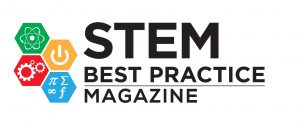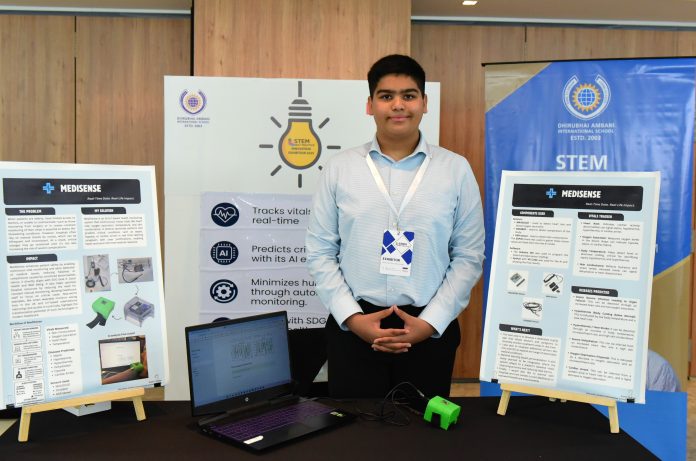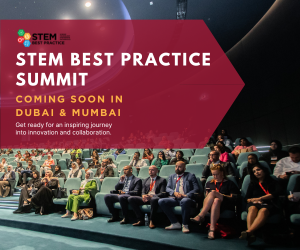Project Title: MediSense
Student Name: Aryan Sharma
School Name: Dhirubhai Ambani International School (Grade 11)

Abstract
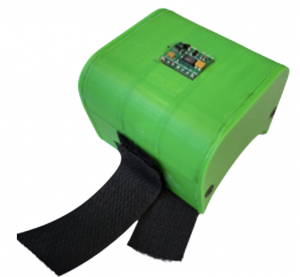 MediSense is an AI-IoT-based health monitoring system designed to provide continuous, real-time monitoring of critical patient vitals. The device tracks oxygen saturation, heart rate, body temperature, and skin conductance using a custom-designed wearable PCB powered by ESP32 and biosensors. Unlike conventional patient monitoring, MediSense uses AI to detect abnormalities and predict critical conditions such as sepsis, hypoxia, hyperthermia, hypothermia, dehydration, and cardiac arrest. The AI based predictions also promote interpretability: each one is explained with justifications based on the underlying vital readings. This feature helps doctors and caregivers respond quickly with a clear understanding of why an alert was triggered. The current version is a local, real-time system with results displayed on a laptop. Future development includes integrating remote monitoring through a mobile app, adding ECG/EEG sensors, and personalizing predictions to each patient’s baseline. Therefore, MediSense showcases how AI and IoT can be utilised in the medical field to make patient monitoring more smart, affordable, and reliable.
MediSense is an AI-IoT-based health monitoring system designed to provide continuous, real-time monitoring of critical patient vitals. The device tracks oxygen saturation, heart rate, body temperature, and skin conductance using a custom-designed wearable PCB powered by ESP32 and biosensors. Unlike conventional patient monitoring, MediSense uses AI to detect abnormalities and predict critical conditions such as sepsis, hypoxia, hyperthermia, hypothermia, dehydration, and cardiac arrest. The AI based predictions also promote interpretability: each one is explained with justifications based on the underlying vital readings. This feature helps doctors and caregivers respond quickly with a clear understanding of why an alert was triggered. The current version is a local, real-time system with results displayed on a laptop. Future development includes integrating remote monitoring through a mobile app, adding ECG/EEG sensors, and personalizing predictions to each patient’s baseline. Therefore, MediSense showcases how AI and IoT can be utilised in the medical field to make patient monitoring more smart, affordable, and reliable.
Introduction
When patients are elderly, have limited access to doctors, or are unable to communicate, such as those recovering from surgery or comas, they require constant monitoring to check for abnormal vitals and detect life-threatening conditions like sepsis, respiratory failure, hypoxia, severe dehydration, etc. However, most hospitals rely on manual monitoring of these vitals by nurses at regular intervals, which is both labor-intensive and prone to delays in detection. This delay can be the difference between timely intervention and irreversible damage. MediSense was created to address this gap. By combining the affordability of IoT devices, the intelligence of AI, and the precision of biosensors, the system provides continuous monitoring and interpretable alerts driven by AI.
Research & Background
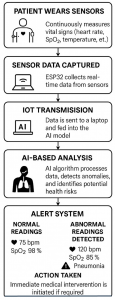 Despite advances in medical technology, timely detection of critical conditions remains a persistent challenge. Current hospital-based monitoring systems are effective but expensive and dependent on specialized infrastructure. In many regions, particularly rural or resource-constrained settings, these devices are not available. At the same time, consumer wearables, while affordable, are designed for lifestyle and fitness tracking, not clinical reliability. They may detect heart rate or temperature, but they do not provide medical-grade accuracy, nor do they interpret data to predict conditions. MediSense directly provides a solution by providing a smart, reliable, and affordable system for continuous patient monitoring. However, unlike traditional devices, it not only measures vitals but also interprets them through Al, providing predictions on diseases a patient may have based on abnormalities found in vitals.
Despite advances in medical technology, timely detection of critical conditions remains a persistent challenge. Current hospital-based monitoring systems are effective but expensive and dependent on specialized infrastructure. In many regions, particularly rural or resource-constrained settings, these devices are not available. At the same time, consumer wearables, while affordable, are designed for lifestyle and fitness tracking, not clinical reliability. They may detect heart rate or temperature, but they do not provide medical-grade accuracy, nor do they interpret data to predict conditions. MediSense directly provides a solution by providing a smart, reliable, and affordable system for continuous patient monitoring. However, unlike traditional devices, it not only measures vitals but also interprets them through Al, providing predictions on diseases a patient may have based on abnormalities found in vitals.
Literature Review and Data Foundations
The Al model in MediSense was not built as a simple rule-based system. Instead, it was trained on augmented data created from an extensive review of medical literature. Research papers and clinical guidelines were studied to understand how different diseases affect patient vitals. For example, sepsis typically manifests as elevated temperature, tachycardia, and reduced SpO₂, while dehydration corresponds to increased heart rate and changes in skin conductance. From this review, data distributions and thresholds were extracted and augmented to create a synthetic dataset representing various health conditions. This approach ensured the Al was exposed to realistic variations in vitals that correspond to specific diseases, allowing it to learn predictive patterns instead of relying solely on fixed thresholds.
Sensor Selection Rationale
Another important aspect of the project was identifying the optimal combination of sensors. Many biosensors exist, including ECG patches, blood pressure cuffs, and EEG electrodes, but the challenge was to select a set that reveals the most about the human body while maintaining a compact, wearable, and cost-effective form factor. After analyzing trade-offs in size and cost, three sensors were chosen that measured the following vitals: body temperature, heart rate, blood oxygen saturation, and Galvanic Skin Response (or skin conductivity)
Methodology
1. Hardware Integration:
A wearable, custom made PCB was designed with compactness and durability in mind. The
ESP32 microcontroller served as the central processor, chosen for its balance of computational power, wireless capability, and low energy consumption.
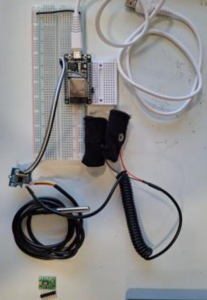
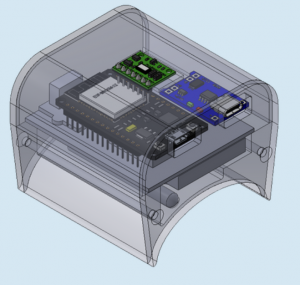
Sensors used were:
○ MAX30102: For SpO₂ and heart rate. This sensor works on the principle of photoplethysmography.
○ DS18B20: A digital temperature sensor known for accuracy and ease of calibration.
○ GSR Sensor: Measures galvanic skin response, which correlates with hydration levels.
The final body of components was encased in a 3D printed hard shell with straps to serve as a working prototype to showcase the implementation of the technology developed.
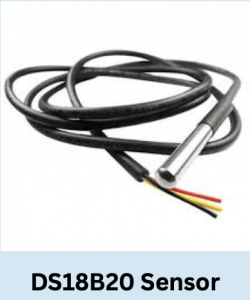
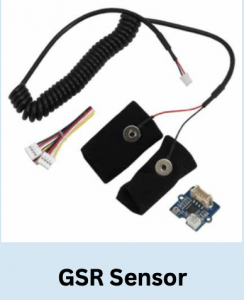
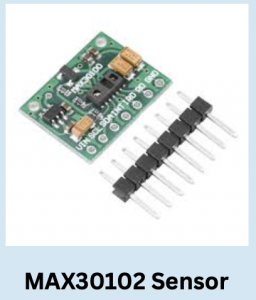
2. Data Acquisition & Filtering:
Signals collected from sensors often contained noise due to movement or environmental factors. Hence, filtering algorithms to remove random anomalies and sensor spikes were applied to stabilize SpO₂ and HR readings. Along with this, temperature data was corrected with an offset to compensate for the wrist – core temperature difference.
3. AI Model Development:
The Al model in MediSense was trained on augmented datasets derived from an extensive review of medical literature and clinical guidelines. Patterns of how diseases affect vitals, such as sepsis or dehydration, were extracted and used to generate records. These augmented datasets exposed the model to realistic variations, allowing it to learn real life based predictive patterns.
4. Software Dashboard:
A Streamlit-based application visualizes vitals in real-time on a laptop. The dashboard includes graphs of vital trends, current condition predictions, and text-based justifications. Additionally, a PDF export feature provides a record of monitoring sessions.
Project Results
Deliverables:
● A wearable hardware prototype with integrated biosensors.
● An AI engine capable of predicting six conditions: sepsis, hypoxia, hyperthermia, hypothermia, dehydration, and cardiac arrest.
● A laptop-based real-time interface running locally with justifications for each alert.
● PDF report generation for documentation.
Key Results:
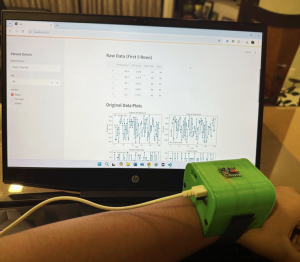
● MediSense provided a more complete assessment compared to single-sensor devices. For
example, detecting hypothermia requires combining both temperature and heart rate trends.
● The system’s explanations also increased interpretability. Instead of only stating “Condition detected,” it specified the combination of abnormal vitals.
● By building on low-cost components, the prototype demonstrated accessibility and feasibility as a scalable solution for resource-limited settings.
Conclusion
MediSense as a device shows how an AI-IoT system can revolutionise patient monitoring by making it continuous, interpretable, and affordable, reducing dependency of manual monitoring by hospital staff and implementing a self-sufficient and automatised system increasing the safety of patients in both homes and hospitals.
Unlike conventional devices, MediSense does more than measure vitals: it analyzes them in real time to predict life-threatening conditions such as sepsis, hypoxia, hypothermia, hyperthermia, dehydration, and cardiac arrest, while providing justifications for its alerts so caregivers and doctors see both the disease and the reasoning. This allows MediSense to be an aid rather than a replacement to conventional doctors. Its functionality of providing justifications along with a predicted illness enables hospital staff to make quicker and more accurate decisions. The medical impact of MediSense is clear: by detecting abnormalities early, MediSense reduces the likelihood of undetected emergencies and helps prevent avoidable complications. For immobile individuals, or those who are recovering from a coma/surgery, who require constant monitoring. MediSense offers an automated monitoring system that reduces reliance on continuous human supervision by persistently tracking vitals and showing alerts when needed. Hence, it also improves hospital workflow by allowing doctors and nurses to focus on critical cases rather than routine checks.
 The societal impact aligns directly with UN Sustainable Development Goal 3 (Good Health & Well‑Being), expanding advanced monitoring beyond ICUs and into rural hospitals and home‑care contexts where resources and staffing are limited. In this way, the project not only improves individual patient safety but also contributes to making predictive monitoring more equitable and scalable.
The societal impact aligns directly with UN Sustainable Development Goal 3 (Good Health & Well‑Being), expanding advanced monitoring beyond ICUs and into rural hospitals and home‑care contexts where resources and staffing are limited. In this way, the project not only improves individual patient safety but also contributes to making predictive monitoring more equitable and scalable.
The project has also been strengthened through hospital feedback and mentorship: during a demonstration at Balaji Hospital in Jodhpur, Dr. C.K. Lohra commended the innovation, highlighted its affordability relative to costly ICU grade sensors, and emphasized its suitability for rural setups and home‑care scenarios.
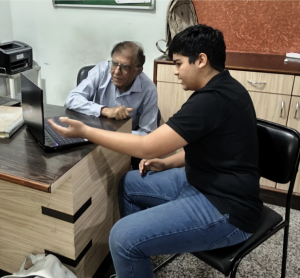
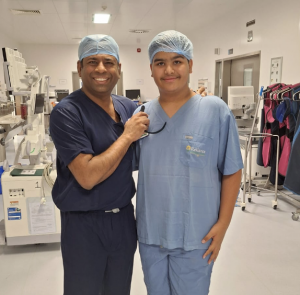
Along with this, exposure to medical technology through internships at Sir H. N. Reliance Foundation Hospital under Dr. Vaibhav Bagaria has provided guidance on aligning system features, including connectivity and usability, with clinical workflows and information systems. These experiences have helped refine practical considerations like integrating Wi‑Fi connectivity to link with hospital CMS systems. Looking ahead, the roadmap prioritizes a dedicated mobile application for remote dashboards and real‑time notifications, extending continuous monitoring to clinicians and families across home and rural environments without requiring costly infrastructure. Apart from this, planned integrations with Wi‑Fi and hospital CMS systems are being considered to make MediSense one with hospital workflow. Additional sensors, particularly the ECG, will broaden the range of detectable conditions, further improving precision while maintaining the system’s affordability. To improve adaptability, machine learning personalization too will be added so thresholds adapt to each patient’s baseline, reducing false alarms and improving long‑term reliability in dynamic, real‑world settings. Finally, partnerships with hospitals and care centers are planned to pilot MediSense in real‑world environments, generate operational feedback, and iterate on usability and alert thresholds.
In conclusion, the MediSense project successfully shows the viability of an affordable Al-loT system for continuous patient monitoring. The system’s main innovation lies in its ability to translate abnormalities in vital signs into interpretable, real-time predictions for life-threatening conditions. By integrating low-cost biosensors sensors with a custom-trained Al model, MediSense works as a prototype for enhancing patient safety in diverse clinical settings, including those with limited resources. Future development will focus on clinical validation through pilot studies and integration with hospital information systems, aiming to position MediSense as a scalable tool to improve the efficiency of clinical workflows and ultimately, improve patient outcomes.
About the author:
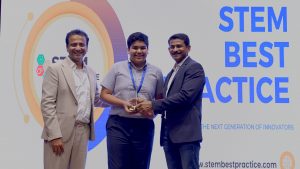 Aryan Sharma is a passionate innovator in AI, robotics, and electronics, currently studying in Grade 11 at Dhirubhai Ambani International School. He actively promotes STEM education through community events and mentoring. He led a robotics workshop at the Kala Ghoda Festival 2022, mentored government school students, and hosted the TeenTech Rally 2022–23 competition. At the G20 Digital Innovation Alliance Summit, he co-hosted a stall to showcase student innovation.
Aryan Sharma is a passionate innovator in AI, robotics, and electronics, currently studying in Grade 11 at Dhirubhai Ambani International School. He actively promotes STEM education through community events and mentoring. He led a robotics workshop at the Kala Ghoda Festival 2022, mentored government school students, and hosted the TeenTech Rally 2022–23 competition. At the G20 Digital Innovation Alliance Summit, he co-hosted a stall to showcase student innovation.
He developed ShotCircuit, an AI-powered web app that suggests hands-on projects by identifying electronic components commonly found in household devices. Aryan has represented India in top global robotics competitions including FTC, VEX IQ, and FRC, winning honors such as the Inspire Award, Excellence Award, and Finalist Alliance recognition. Academically, he ranked in the top 7.5% nationally in the Dr. Homi Bhabha Science Exam, earned top positions in Olympiads, and received an Honorary Mention in the CGS Technovation Master Coder competition as its youngest participant.
In 2024, Aryan was awarded the Best Innovative Idea Award at the STEM Best Practice Innovation Exhibition and Summit, held at the Nehru Science Centre, Mumbai. He was also selected as a Student Speaker, where he presented his innovation, MediSense, among participants from schools across India. He is currently pursuing a Summer Observership at the Robotics Lab of Reliance Foundation Hospital in Mumbai, under the mentorship of Dr. Vaibhav Bagaria and Dr. Vishal Keswani, gaining hands-on exposure to advanced medical robotics.

